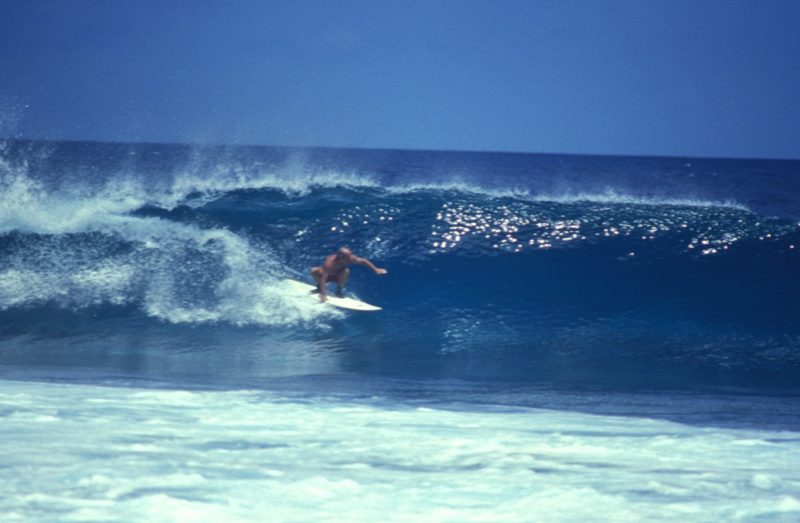ASB investigates the surf industry’s quest for ‘greener’ wetsuits.
Spongy, tough and inoffensive, neoprene is the stuff that’s – literally – close to all our hearts. It offers warmth, buoyancy and impact resistance. It smells vaguely chemical when new, and reverts to a mouldy pong after heavy use. It keeps your body warm and your beer cold. It’s also more correctly known as polychloroprene, and is a form of vulcanised rubber which came about after DuPont chemicals successfully reacted monovinyl acetylene with hydrogen chloride gas. It comes from crude oil and it winds up in landfill. Suddenly sounds a little less benign, doesn’t it.
Surfers, as consumers, are caught in an interesting dilemma. Tiny increments in design make a massive difference in performance; frequently the difference between domination and a humiliating slap-down. Technological refinement is therefore highly sought after. But we’re all intimately bound up in the natural environment, immersing ourselves in the ocean day after day, and baking under the sun. Where we can, most of us would like to reflect that intimacy by being responsible about the environment.
The contradiction at the heart of our culture, ever since day one, has been that the equipment we use is toxic. Boards and wetsuits, rashies, legropes, sunglasses, deck grip – pretty much everything on the shelves of your store – is petroluem based, designed for single use, heavily transported from manufacture to point of sale, and non-recyclable. Inroads are being made in some areas – notably the recycled surfboard – but significant industry blind spots remain, and chief among these, arguably, are wetsuits. They’re not called exposure suits for nothing: if they were even slightly bio-degradable, they would fail in their main purpose – resisting the combined attacks of moisture, temperature and UV exposure.
Wetsuits are like most other manufactured consumer goods, in that their “greenness” can be assessed as a function of their composition, the supply chain involved in getting them from maker to user, or their end-of-life re-use. These different aspects of the product’s life cycle are in fact interdependent. As Don Munro of XXX wetsuits points out, “you’re better off starting with green materials in the first place, because otherwise you’ll only expend more energy trying to convert the stuff for recycling at the end.” Paul Manners at Westsuits makes a similar point: “You’ve got to transport them to, say, China, for the process to take place. Then you’ve got to expend more energy getting the nylon and glue off the rubber before you even start.”
“They’re not called exposure suits for nothing: if wetsuits were even slightly bio-degradable, they would fail in their main purpose – resisting the combined attacks of moisture, temperature and UV exposure.”
Composition
The performance expectations we apply to wetsuits are a major impediment to any change in materials. But the problem’s not insurmountable; car makers say they expect absolute performance integrity from car tyres, yet Goodyear have successfully launched a tyre incorporating corn starch. It can be done.
There’s consensus that the drive for green suits thus far has come from the makers, not the users. “It’s definitely come from the brands,” says Billabong’s John Mossop. “Environmental products cost more and this is a huge hurdle when presenting these products to consumers.” Don Munro goes further, saying he’s never had a single customer ask him about the green credentials of his suits. But commercially, he also knows this is a potential point of difference which might attract customers. Nathan Lyons at Speakys surfshop in Geelong confirms the same point from a retail perspective: his customers might respond positively to a “green” suit, he says, but they’ve never yet asked him for one.
There’s an expectation in the industry that the big brands will drive the expensive research and development. One independent manufacturer said “for smaller organisations the commercial imperative of product development drives us to a position where we meet the market, not lead it. It is the market leaders that have the budget to spend on leading the industry.”
The charge towards a suit made from green materials has been led in the marketplace by Body Glove and Patagonia. Body Glove’s “eco” wetsuit features “eco flex” outer lining and “bio-stretch” rubber. The suit has been nominated for SIMA’s environmental product of the year. It evolved from refinements made by the company in the area of personal flotation devices (PFDs), and features a recycled plastic key holder and water ink graphics, but the company claims the rubber is the big deal. It’s made from limestone (calcium carbonate), a process which has always been available but which until recently has not been cost competitive against petroleum-based neo. It last appeared on the market approximately 10-15 years ago at the time of the last major oil shock. Refinements in production by Yamamoto in Japan, coupled with increases in the cost of crude, and the closure of two Du Pont plants, have brought it back into contention. Although Taiwan’s Sheico accounts for over 60% of the international market in neoprene sheets, (equating to about 3.5 million wetsuits a year) Yamamoto claim to have the high ground in quality. Other makers such as Nanbei and Keeptop (China), and Zenith Rubber (India) make up the balance.
Some manufacturers claim the use of limestone is not new to wetsuit technology and isn’t necessarily a green solution. Rip Curl’s Cameron Lamperd told ASB that 90% of the neoprene currently finding its way into wetsuit manufacture is already limestone based, but not everyone’s promoting the fact. “We came across the use of limestone neo on a visit to the Taiwan makers” he says. “They had no idea it could be presented to the public as green. They were just substituting it because it had become affordable as against petroleum-based neo. A year ago, we decided we’re not comfortable tagging the stuff as environmentally friendly. That’s not a legal position – it’s about our credibility in the market.”
Patagonia’s “Regulator” series suits are also made from 98% Yamamoto limestone rubber, and come with a merino wool/recycled polyester lining. The wool is chlorine free, and the kneepads are PVC-free. The suits won the 2006 EuroSIMA Special Prize of the Jury for Ecological Innovation. They’re surprisingly hard to obtain though: they can’t be bought online, and are only available for retail sale via the Cardiff, Florida store. Despite the positive reception of the design, Patagonia have withdrawn some of the “green” claims they’d made about it on their website. One theory is that Patagonia are still in the development phase with these suits, and that they don’t want to risk a full-scale rollout of the concept just yet. A handful of user reviews on 70percent.org seem to conclude that the suits are light and flexy, remarkably comfortable, but lack durability.
Dave Lester, global vice-president of Quiksilver, confirmed to ASB that Quiksilver has been testing limestone-based neo, non-solvent glues and jerseys made from recycled materials as well as bamboo. He says “The problem is that the limestone-based material is heavier, less flexible and quite a bit more expensive than current petroleum-based materials. Our goal is to get this material into a price range that makes it more attractive to the retail customer and to get the material to the same or better performance standards as our current materials. The general public is willing to pay more for these types of eco-friendly products, but only to a point.” Quiksilver are also looking at water based non-solvent inks, recycled nylon for zipper pulls and zippers, using fewer hang tags on the products and ensuring they’re made with cleaner materials. Dave says “One of our short term goals is to work with our suppliers to move away from solvent based adhesives (which are used to laminate nylon jersey to the neoprene and to glue panels together). The main challenge is developing a non-solvent based adhesive that works with solvent based neoprene.”
West Surfing Products, the makers of Westsuits, have ventured further afield. They’re about to release a rash vest made from 64% recycled PVC water bottles and 25% bamboo carbon. It feels exactly like other rash vests on the market, is light, stretchy and UV resistant, and will retail at a similar price point to conventional rashies. They’ve also looked recently at developing non-solvent based adhesives for the lining of their suits.
Greg Clarke, VP of Product Development at O’Neill Wetsuits, has just returned from a study tour amongst Asian neoprene producers. “I’m confident that in the next couple years, we’ll see a significant increase in the use of greener components from all the wetsuit companies” he says.
But there’s a great deal of variability in the claims wetsuit companies make about the limestone-based neo. Californian brand Matuse are among those (including Body Glove and Patagonia) who lean heavily on the environmental superiority of the Yamamoto material (which Matuse style as “geoprene”), claiming it’s “kinder to mother nature since it doesn’t come from petroleum.” And there’s more: “Standard, old-fashioned neoprene is petroleum-based: It’s messy, it’s hazardous, it goops up sea otters. Yamamoto Geoprene is derived from limestone that’s 99.7% pure. And the purity of its limestone source – an ancient misty Mesozoic mountain – is also why Geoprene is so top notch. Yamamoto estimates that their reserve of limestone will last approximately 3,000 years.” Matuse are more or less right about the limestone deposit – it’s mined by a Japanese firm called Denka, but it’s not exactly taken out by hobbits with wheelbarrows, as the “misty mountain” line seems to imply. It takes massive infrastructure, and massive carbon emissions, to convert the limestone to the acetylene which is used in the neoprene.
The skeptics are bristling at some of the claims circling the industry right now. Management at one of the big brands told ASB “You’d have to take several steps backwards to do it (produce a sustainable wetsuit). You’d be giving up a lot of function.” Environmental website Treehugger have posted claims that “calcium carbonate actually requires more energy to heat up than standard neoprene. Calcination of limestone using standard equipment (a pressure kiln or gas chamber kiln) needs heat up to ≈850˚C. Standard neoprene, which by the way, already contains calcium carbonate, requires ≈400 °C. (In other words) the temperature is more than doubled in order to make this eco-friendly rubber. More heat requires more energy, and more energy means more carbon dioxide in the atmosphere.”
Other companies using the Yamamoto limestone neo prefer to market their suits on the basis that the quality is better, rather than mounting claims about sustainability. These include Seventhwave (Christchurch, NZ), Aqua Glide (USA), American Bicycle Group, 2XU, Zoot and Blue Seventy triathlon suits. Peter Coles, Rip Curl’s head of global sourcing, points out that in buying neoprene, performance is still the main criterion: “We give the technical requirements to the maker, in terms of flex, warmth and weight. We don’t pass judgment on the chemical processes they use to achieve those ends.” Paul Manners at Westsuits agrees: “On the east coast of the USA, around Maine, there’s guys surfing in snow. Those guys are not going to compromise warmth for greenness.”
The performance credentials of the material are indeed impressive – the “closed cell” content is said to be more than 93%, 22-33% higher than regular neo at 60-70%. Yamamoto say they use nitrogen gas inside each individual closed cell for improved heat retention and efficiency (although major brands have countered that all neoprene is nitrogen filled). The higher closed-cell count is believed to improve buoyancy and resistance to compression damage. The material feels light and soft, and is capable of 480-580% elongation (by comparison, the human skin’s maximum elongation, according to Hannibal Lecter, is 60-70%). Matuse say their Yamamoto rubber has a low surface friction coefficient of 0.032, whereas old-world neoprene’s drag coefficient is 4.0., Seventhwave’s website claims that it’s “ridiculously warm and stupidly stretchy.”
Supply chain
No matter which brand you buy, it’s likely that your wetsuit is a global citizen. Purchasing of neoprene in Taiwan, followed by construction in mainland China and global distribution is a common approach. Take the Nineplus suit. The company’s based in Cornwall, UK, the neoprene is Japanese Yamamoto, whilst the zips are from Israel. They retail all over the United States and will ship internationally via the internet. Consider the packaging, handling and freight involved in this exercise.
Given the severe limitations at the beginning and end of a wetsuit’s life-cycle, supply chain reform is the area in which wetsuit makers can improve environmental performance. The suit mightn’t look or feel any different, but carbon emissions associated with manufacturing could be drastically reduced. There’s a hip phrase for this reform – it’s called Supply Chain Environmental Management, or SCEM. Large makers such as Rip Curl now have dedicated executives studying their supply chain, and they’re honing in on packaging. Rip Curl’s plastic bags have gone from full-length to half length, and they believe they will shortly be able to revolutionise their distribution techniques.
“Given the severe limitations at the beginning and end of a wetsuit’s life-cycle, supply chain reform is the area in which wetsuit makers can improve environmental performance. The suit mightn’t look or feel any different, but carbon emissions associated with manufacturing could be drastically reduced.”
One of the philosophies of the SCEM disciples is that a manufacturer should take environmental responsibility for a product throughout its lifespan, not simply waving it goodbye at point of sale. Although most surfers would testify that after sales service from wetsuit makers is generally very strong, that service relates to taking responsibility for the wetsuit’s performance, not its environmental impact. And unlike warranty, SCEM works backwards from the moment of sale, as well as forwards: that is, it looks at the relationship between a manufacturer and its upstream suppliers. An international report on SCEM practices in the electronics industry in 1999 concluded that “suppliers are being asked to collaborate on finding solutions to environmental problems” and those “who demonstrate skill and ingenuity…will likely receive customer loyalty. These partnerships represent a shift from the old business model of communicating with suppliers primarily through purchase orders, to one of shared problem solving.” Returning to the “point of difference” argument raised above, a swing tag promoting an accredited “green” supply chain all the way to the rack in the store, may be as impressive to the retail customer as one which trumpets the use of “green” materials. It’s a complex exercise indeed to calculate the amount of fossil fuel input into a conventional wetsuit, but a proportion of the input must be capable of being reclaimed by more efficient handling, packaging and transport. Greg Clarke at O’Neill reports that amongst the neoprene producers he’s seen in Asia, “Most of them are taking huge steps toward a greener environment throughout the manufacturing process.”
Some manufacturers now publish blacklists of toxic ingredients they will no longer accept from their suppliers, or require their suppliers to reduce packaging, or make it more recyclable. In a project called the Footprint Chronicles, Patagonia plans to publicly track the paths of 10 of its products this year, all the way from the design studio to its distribution center in Reno, Nevada, according to Fast Company magazine.
Recycling
Wetsuits wind up, one way or another, in landfill. Almost every maker who spoke to ASB pointed out that a wetsuit is a chemically complex product, and is not easily recycled without further energy expenditure. It’s a reasonable argument, but is it any more complex than a running shoe? Nike now turns scrap footwear material into a composite product called Nike Grind, which is then donated back to community groups to resurface playing fields. Nike is also aiming to have all its facilities and travel carbon neutral by 2011.
Ending the assumption of single use is a starting point. Is a steamer with leaky seams really a “dead” product? Quality of construction also has a role here: if a suit is well made, the wearer won’t add to landfill by replacing it, as Paul Zarifeh of Seventhwave points out: “The best thing we have found with Yamamoto is the neoprene lasts so much longer than (competing producers),” he says. “We have customers who get 6-7 years out of a winter suit, which is virtually unheard of in other brands.” The makers readily concede that they don’t know what surfers do with their old suits, unless they come back under warranty. Secondhand sale or donation are possibilities, but the wheelie bin seems the most likely destination. John Mossop at Billabong says they try to resuscitate rather than euthenase: “We try as hard as we can to repair as many wetsuits as possible so we are not adding to land fill.”
Rip Curl have a project team working on a ‘grind’ product of their own. Focusing on offcuts and returns, they reconstitute the neoprene into a composite material for footwear soles. Given the relative proximity of their largest landfill producer, the Chang Mai plant in Northern Thailand, and their main footwear manufacturer in Indonesia, there’s a neat symmetry about the scheme. Having ownership of their own production facilities gives Rip Curl both an opportunity and a corresponding responsibility, to exert control over the disposal of scrap neoprene. They’re looking at creating a campaign around the idea, asking surfers to return old wetsuits to them for recycling. “We’re really excited about it,” says Peter Coles. “The French arm of the company have been pushing us on this issue, and we think it has great potential. We’re talking about hundreds of thousands of square metres of landfill per year.” The aim will be to focus the project at each of the main sales centres for Rip Curl product, in order to minimise weight in transportation of the materials. The global wetsuit team at the company are due to give the concept a major push at their next meeting on 12 May.
Recycling raises other thorny issues though. Firstly there’s the energy and cost involved in isolating the neoprene. “The problem” says Dave Lester “is the base neoprene material and the laminated nylon jersey. So far the companies can’t use this combination.” (Although O’Neill’s Greg Clarke told ASB that they’re “now focusing on a way to recycle the jersey materials. It’s complicated and it will be a long-term process, but I think we’ve made significant progress.”)
A materials chemist in Melbourne recently told a gathering that playground surfaces made from reconstituted rubber scraps can be shown to give off toxic gases as they heat and cool under UV exposure. So there’s ideological encouragement on the one hand for producers to take responsibility for their product all the way through to some other incarnation like playground rubber, but potentially a new kind of liability emerges as the product changes form.
The conclusion…it’s not easy being green
“It’s unsexy, but the real gains will be made in supply chain reform and recycling. Makers are also on safer ground marketing their green credentials in these areas, but sadly it’s complex and boring, and therefore hard as hell to market.”
There’s an odd mixture of excitement and despondency about improving environmental performance in the surf wetsuit industry. One maker told ASB “the industry’s drive is towards wowing ourselves with our ability to make warm super comfortable suits that will be in the landfill sooner than older styles.”
Benefits sometimes arrive in strange ways. Last year, neoprene manufacturers made an unintended contribution to environmental efforts when they were sued in California for price fixing. The resultant payout of US$3million was divided amongst 17 community organisations with strong records on environmental protection. The largest beneficiary of the funds was the Surfrider Foundation.
At the risk of provoking an industry backlash (or maybe in the hope of it…), here are a handful of ideas which kept recurring in ASB‘s discussions with the makers:
1. Big brands will have to educate consumers and push them to demand change. Even then, only some brands will carry that responsibility. The giant bulk makers of cheap suits (e.g. for wakeboarding), who supply franchises like Costco, won’t initiate change.
2. Marketing restraint will serve everyone in the long run. Green claims should be accredited and widely accepted before being used as a selling point. Otherwise, ‘green fatigue’ will cause the customer to ignore the issue once again, and shop on performance and price preferences alone.
3. Changing the composition of wetsuits is the hardest road to reform. There’s no sign of a miracle material around the corner. The use of limestone raises a complex debate, and discussion will rage for some time yet on the true environmental benefits.
4. It’s unsexy, but the real gains will be made in supply chain reform and recycling. Makers are also on safer ground marketing.
Words: Jock Serong










